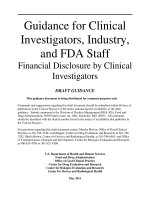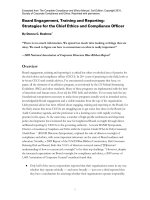HANDBOOK ON CHEMICAL WEAPONS CONVENTION FOR INDIAN CHEMICAL INDUSTRY AND CHEMICAL TRADERS ppt
Bạn đang xem bản rút gọn của tài liệu. Xem và tải ngay bản đầy đủ của tài liệu tại đây (7.08 MB, 208 trang )
1
HANDBOOK ON CHEMICAL WEAPONS
CONVENTION FOR INDIAN CHEMICAL
INDUSTRY AND CHEMICAL TRADERS
2
DEPARTMENT OF CHEMICALS & PETROCHEMICALS,
MINISTRY OF CHEMICALS & FERTILIZERS
GOVERNMENT OF INDIA, NEW DELHI
April, 2010
3
INDEX
Sr.no. Contents Page No.
1. Introduction 5
2. Chemical Weapons Convention (CWC) 7
3. The CWC Act, 2000 8
4. Government of India Notifications related to CWC 9
5. CWC Declarations 10
5.1 Schedule chemicals and Discrete Organic Chemicals 10
5.2 Declaration criteria for Schedule chemicals and unscheduled
Discrete Organic Chemicals (OCPFs)
11
5.2.1 Schedule 2 Chemical 11
5.2.2 Schedule 3 Chemical 11
5.2.3 Other Chemical Production Facilities (OCPFs) 12
5.3 List of schedule 2 chemicals, and commonly traded
schedule 2 chemicals
12
5.4 List of Schedule 3 chemicals 13
5.5 Identification of Scheduled / Unscheduled Chemicals 13
5.6 Deadline for various declarations 13
5.7 Industry Declaration forms 14
5.7.1 Declaration forms for Schedule 2 Chemical 14
5.7.2 Declaration forms for Schedule 3 Chemical & OCPFs 14
5.7.3 Guidelines for completing declaration forms 15
5.8 Specific explanations 20
5.8.1 Specific explanations relating to industry declarations 20
5.8.2 – 5.8.5 Specific explanations relating to Schedule 2 & 3 Chemicals 22
5.8.6 Specific explanations pertaining to OCPF declarations 25
5.8.7 – 5.8.8 Common problems in declaring OCPFs 27
4
5.9 Description of Codes used in declaration forms 28
5.10 Confidentiality classification 30
6. General procedure for export & import of Schedule
Chemicals
30
7. Verification (Inspection) of plant sites by OPCW Inspection
Team
31
7.1 Rules of Verification 31
7.2 National Escorts 32
7.3 Verification of Schedule 2 Chemical facilities 33
7.4 Verification of Schedule 3 Chemical facilities 40
7.5 Verification of OCPFs 45
7.6 Inspection features of Schedule chemicals and unscheduled
Discrete Organic Chemicals (OCPFs)
48
8. Frequently asked questions (FAQs) & their answers 49
9. Annexes 68
Annex A - Annex on Chemicals 68
Annex B - The CWC Act, 2000 76
Annex C - Government of India notifications related to CWC 103
Annex D - Industy Declaration forms 128
Annex E - Appendices for description of Codes for
completing declaration forms
160
Annex F - Member States & Non-Member State
Parties to the Convention
169
Annex G -The Template for Pre - Inspection Briefing 177
Annex H - The Tentative plan for inspection of a
Schedule 2 facility
200
Annex I - The Tentative plan for inspection of a
Schedule 3 facility
201
Annex J - The Tentative plan for inspection of an
Other Chemical Production Facility
202
Annex K - Glossary of Terms 203
Annex L - End use certificate 205-6
Annex M - Guidelines regarding low-concentration limits for
declarations of schedule 2A and 2A* chemicals
206-7
5
INTRODUCTION
Chemical Weapons Convention (CWC) is a universal non-discriminatory, multilateral,
disarmament treaty that bans the development, production, acquisition, transfer, use,
stockpile or retain chemical weapons (CW). The treaty puts all the States Parties on
an equal footing. Countries having stockpiles of chemical weapons are required to
declare and destroy them in a specified time frame and those, who produce and use
chemicals that can be converted into chemical weapons have to be open and
transparent about the use they put these chemicals to. The CWC also requires the
complete and verifiable (inspectable) destruction of existing CW stockpiles. The
CWC addresses one of the national programme and indirectly addresses the threat
of chemical terrorism.
The Conference on Disarmament, Geneva adopted the Convention on 3
rd
September, 1992. The CWC was opened for signature on 13
th
January, 1993. As on
31
st
March. 2010, 188 Countries are States Parties (i.e. Member Countries to the
CWC). The States Parties are those Countries who have deposited their instruments
of ratification. As on 31
st
March. 2010, there are only 2 signatory States which have
not yet ratified the Convention. There are also 5 States, who have neither signed nor
acceded to the Convention as on 31
st
March. 2010.
India is one of the early signatory country and signed the Convention on 13th
January, 1993. The instrument of ratification was deposited by India on 3
rd
September, 1996 making it the 62
nd
State Party to ratify the Convention. The pre-
requisite for the Convention to come into force was the deposition of 65
th
instrument
of ratification and the same was achieved on 31
st
October, 1996. The Convention
entered into force on 29
th
April, 1997.
India is obliged to declare information on certain chemical activities to the
Organisation for the Prohibition of Chemical Weapons (OPCW) head quartered at
The Hague, The Netherlands and allow routine inspection of relevant chemical
facilities by the OPCW Inspection Team.
6
Declarations of plant sites for Schedule 2, Schedule 3 and unscheduled Discrete
Organic Chemicals (DOC’s) and their verification (i.e. inspection) are two important
obligations on chemical industries.
To implement the Convention, The CWC Act, 2000 was passed by the Parliament
and assented to by the President of India. The Act came into force on 1
st
July, 2005
through the Gazette Notification No. 598 dated 14
th
June, 2005, ( S.O 818(E)). The
Government of India has also established National Authority for implementing the
provisions of CWC.
7
2. CHEMICAL WEAPONS CONVENTION (CWC)
CWC covers the followings. The relevant contents of CWC pertaining to
chemical industry are placed at Annex –A (Pages 67 - 74 of the handbook).
Text of CWC can be seen at any of the web sites, namely -
www.chemicals.nic.in, www.nacwc.nic.in, www.opcw.org
CONTENTS Page No.
Annex A - Annex on Chemicals (Schedule 1, 2 & 3) 67 - 74
8
3. THE CWC ACT, 2000
The CWC Act, 2000 is placed at Annex – B (Page 75 of the handbook).
The Act covers the followings-
CHAPTER Page No.
Chapter I Preliminary 77
Chapter II Establishment of The National Authority and its Powers
and Functions
80
Chapter III Prohibition & Regulations of Chemical Weapons and
Toxic Chemicals
84
Chapter IV Registration of Persons as Producers, Users, etc. 86
Chapter V Inspection, Search, Seizure & Forfeiture 87
Chapter VI Offences & Penalties 95
Chapter VII Miscellaneous 99
9
4. GOVERNMENT OF INDIA NOTIFICATIONS
RELATED TO CWC
Annex C (page 102) provides these notifications
a) No. 598 dated 14
th
June, 2005 regarding enforcement of CWC Act. [S.O. 818
(E)] (Page No. 103)
b) No. 598 dated 14
th
June, 2005 regarding establishment of The National
Authority. [S.O. 820 (E)] (Page No. 104)
c) No. 257 dated 14
th
June, 2005 regarding CWC Appeals Rules, 2005(Page No.
105)
d) DGFT notifications on Export & Import of Schedule Chemicals (Page No. 116)
.
10
5. CWC Declarations
The following categories of chemicals need to be declared.
5.1 Schedule chemicals and Discrete Organic Chemicals:-
Schedule 1 Chemicals
These chemicals pose the highest risk to the object and purpose of the Convention.
They include nerve agents such as VX and blister agents such as Mustard. Schedule
1 chemicals also include final stage precursors. Schedule 1 chemicals have limited
use for purposes other than those prohibited under the CWC.
Schedule 2 Chemicals
These chemicals pose a significant risk to the object and purpose of the Convention.
They include toxic chemicals and precursors possessing properties that would
enable them to be used in CW related activities. Schedule 2 chemicals may be
produced/consumed/processed in industrial scale quantities for purposes not
prohibited under the CWC.
Schedule 3 Chemicals
These chemicals too pose a risk to the object and purpose of the Convention. They
also include first generation CWA (Chemical Warfare Agent) and other toxic chemicals
and precursors that might enable them to be used in CW related activities. The Indian
chemical industry produces Schedule 3 chemicals in large industrial scale quantities
for purposes not prohibited under the CWC.
Other Chemical Production Facilities (OCPFs)
Discrete Organic Chemical (DOC):
Any chemical not mentioned in Schedules 1, 2 or 3 belonging to the class of
chemical compounds consisting of all compounds of carbon - except for its oxides,
sulphides and metal carbonates, identifiable by chemical name, by structural
formula, if known, and by Chemical Abstracts Service registry number, if assigned.
PSF-Chemical (PSF): A discrete organic chemical containing the elements phosphorous,
sulphur or fluorine. They constitute a subset of DOC,
11
The Indian chemical industry produces DOCs in large industrial scale quantities.
5.2 Declaration criteria for Schedule chemicals and unscheduled
Discrete Organic Chemicals (OCPFs)
5.2.1 Schedule 2 Chemical
Initial and annual declarations are required for all plant sites that
comprise one or more plant(s) which produced, processed or consumed
during any of the previous three calendar years or is anticipated to produce,
process or consume in the next calendar year more than:
(a) 1 kg of a chemical designated "*" in Schedule 2, part A;
(b) 100 kg of any other chemical listed in Schedule 2, part A; or
(c) 1 tonne of a chemical listed in Schedule 2, part B.
State Party (i.e. Govt. of India) shall have to declare Aggregate
National Data (AND) to Technical Secretariat of OPCW on quantities
produced, processed, consumed, imported and exported of each Schedule 2
Chemical for the previous calendar year, as well as a quantitative
specification of import and export for each country involved. Industry is
therefore, required to submit its plant site declaration data irrespective of the
declaration threshold as mentioned above.
5.2.2 Schedule 3 Chemical
Initial and annual declarations are required for all plant sites that
comprise one or more plants which produced during the previous calendar
year or are anticipated to produce in the next calendar year more than 30
tonnes of a Schedule 3 chemical.
State Party (i.e. Govt. of India) shall have to declare Aggregate
National Data (AND) to Technical Secretariat of OPCW for the previous
calendar year on the quantities produced, imported and exported of each
Schedule 3 chemical, as well as a quantitative specification of import and
export for each country involved. Industry is therefore, required to submit its
12
plant site declaration data irrespective of the declaration threshold. as
mentioned above.
5.2.3 Other Chemical Production Facilities (OCPFs)
The initial declarations to be provided shall include a list of all plant
sites that:
(a) Produced by synthesis during the previous calendar year more than
200 tonnes of unscheduled Discrete Organic Chemicals (DOC); or
(b) Comprise one or more plants which produced by synthesis during the
previous calendar year more than 30 tonnes of an unscheduled
Discrete Organic Chemical containing the elements phosphorus,
sulphur or fluorine (hereinafter referred to as "PSF-plants" and
"PSF-chemical").
With regard to plant sites listed as referred at Para 5.2.3(a) above, the list
shall also include the information on the approximate aggregate amount of
production of the unscheduled DOC in the previous calendar year expressed
in the ranges under 1000 tonnes, 1000 to 10,000 tonnes and above 10,000
tonnes
With regard to plant sites listed as referred at Para 5.2.3(b) above, the list
shall also specify the number of PSF - plants within the plant site and include
information on the approximate aggregate amount of production of PSF -
chemicals produced by each PSF - plant in the previous calendar year
expressed in the ranges: under 200 tonnes, 200 to 1,000 tonnes, 1,000 to
10,000 tonnes and above 10,000 tonnes.
5.3 List of schedule 2 chemicals, and commonly traded schedule 2 chemicals
Annex A – Annex on chemicals provides lists of all schedule 2 chemicals. It
also provides CAS registry number and ITC (HS) code for schedule chemicals
and a list of 33 commonly traded Schedule 2 chemicals (page 68 of the
handbook)
13
5.4 List of schedule 3 chemicals
Annex A – Annex on chemicals provides lists of all schedule 3 chemicals. It
also provides CAS registry number, IUPAC chemical name and ITC (HS)
code for schedule 3 chemicals. (Page 71 of the handbook)
5.5 Identification of Scheduled / Unscheduled Chemicals
Compile IUPAC name and CAS No. of all chemicals handled at the plant site.
Determine the molecular formula and/or the chemical structure. Determine if
chemical handled by you contains one or more elements of Phosphorus,
Sulphur, Fluorine, Arsenic and/or Nitrogen.
If answer is yes, consult Annex A - Annex on chemicals, list of commonly
traded Schedule 2 chemicals & “Declaration Hand Book” in the OPCW
website: www.opcw.org/handbook .
5.6 Deadlines for various declarations
Table: Declaration requirements and deadlines for submission
TYPE OF DECLARATION DECLARATION REQUIREMENT AND DEADLINES FOR SUBMISSION
Schedule 2 Schedule 3 DOC incl. PSF
Initial Declarations
Immediately Immediately Immediately
Annual Declarations of
Past Activities (ADPA) -
Activities in the previous
calendar year
Aggregate National
Data Not later than 90
days after the end of
the previous calendar
year – Action GOI
Aggregate National
Data Not later than 90
days after the end of
the previous calendar
year – Action GOI
-
Declarations for Plant
Sites
Declarations for Plant
Sites
Declarations for Plant
Sites
Not later than 21
st
January every year
– Action Industry
Not later than 21
st
January every year
– Action Industry
Not later than 21
st
January every year
– Action Industry
Annual Declarations of
Anticipated Activities
(ADAA) – Activities
planned for the following
calendar year
Declarations for Plant
Sites
Not later than 15th
September every year
– Action Industry
Declarations for Plant
Sites
Not later than 15th
September every year
– Action Industry
-
14
Additionally Planned
Activities
Change After
submitting ADPA
Change After
submitting ADPA
30 days before this
activity begins
– Action Industry
30 days before this
activity begins
– Action Industry
In accordance with decision taken by Technical Secretariat of OPCW, State
Parties (i.e. Govt. of India in our case) should adopt the necessary measures to
ensure that their declarations are submitted prior to the deadlines provided for in the
Convention. Industries are therefore advised to strictly follow the Time Line
mentioned above.
5.7 Industry Declaration Forms
5.7.1 Declaration forms for Schedule 2 Chemical
DECLARATION FORMS
INITIAL
2.0, 2.1, 2.1.1, 2.2, 2.3, 2.3.1, 2.3.2, 2.4, 2.5, 5.0 & 5.1
Annual Declarations of Past Activities
(ADPA) - Activities in the previous
calendar year
2.1, 2.1.1, 2.2, 2.3, 2.3.1, 2.3.2 & 2.4
Annual Declarations of Anticipated
Activities (ADAA) – Activities planned for
the following calendar year
2.2, 2.3, 2.3.1, 2.3.2 & 2.5
ADDITIONALLY
PLANNED
ACTIVITIES
2.2, 2.3, 2.3.1, 2.3.2 & 2.5
Notification Of cessation of
activities
2.9
5.7.2 Declaration forms for Schedule 3 Chemical & OCPFs
DECLARATION FORMS
INITIAL
3.0, 3.1, 3.1.1, 3.2, 3.3, 3.4, 5.0 & 5.1
Annual Declarations of Past Activities (ADPA)
- Activities in the previous calendar year
3.1, 3.1.1, 3.2, 3.3 & 3.4
15
Annual Declarations of Anticipated Activities
(ADAA) – Activities planned for the
following calendar year
3.2, 3.3 & 3.4
ADDITIONALLY
PLANNED ACTIVITIES
3.2, 3.3 & 3.4
Notification Of cessation of activities
3.8
OTHER CHEMICAL PRODUCTION FACILITIES
4.0 & 4.1
All declaration forms are placed at Annex – D. For finding modification of
these forms if any, websites of Govt. of India (www.chemicals.nic.in)
(www.nacwc.nic.in) & OPCW (www.opcw.org/handbook) should be visited.
Contents of forms should not be modified ntial. CWC Help Desk of your region
should be contacted for any clarification. Communication details of CWC Help
Desks are given as answer to FAQ 8.25
5.7.3 Guidelines for completing declaration forms
5.7.3.1 General guidelines applicable to most of the forms
5.7.3.2 Form Header
• Country code: Use IND – three digit country code for INDIA
• Section: It is already mentioned as B
• Page n of n pages: Leave this blank
• Date (ccyy-mm-dd): Enter the date on which the form was completed
Using the format ccyy-mm-dd, example – 2010-03-31 for 31
st
March.
2010
5.7.3.3 Confidentiality mark: To be left blank.
5.7.3.4 Miscellaneous:
• Attempt to print the form
• All entries to be filled in capital letters if the form is hand written
• Do not leave any entry blank
Prefix ISD and STD codes to telephone and mobile numbers. For example
New Delhi phone number should be given as 0091 11 29924358. The
Mobile number should be 0091 9376234567
• Latitude, longitude wherever mentioned in the form need not be filled- in
• Year : Means calendar year
• Calendar year : Begins on January 1 and ends on December 31
16
5.7.3.5 Schedule 2 facilities
Form 2.0
• Serial number 5 : Indicate the preferred address of communication
• Serial number 11: IUPAC chemical name – A schedule chemical can have
many systematic and non- systematic chemical names. The systematic
naming system is developed by International Union of Pure and Applied
Chemistry. Giving IUPAC name is recommended. IUPAC chemical names
of most of schedule 2 chemicals can be found at www.opcw.org/handbook. As
an alternate the chemical name as listed in Annex A - Annex on chemicals
can be provided.
• Serial number 11 continued: CAS Registry Number – The Chemical
Abstracts Service (CAS) registry number for chemical should also be
provided if assigned. CAS registry number for most of schedule 2
chemicals can be found at www.opcw.org/handbook
• Serial number 11 continued: schedule and entry number in schedule can
be found in Annex A - Annex on chemicals.
• Serial number 12 (I): refers to number of schedule 3 plants at the facility
• Serial number 12 (ii): Number of plants where schedule 2 chemical is
produced, processed or consumed.
• Serial number 13: 2A* chemical refers to chemical listed in entry 2A (3) of
Schedule 2. 2A chemicals refer to entries 2A(1) and 2A(2) in schedule 2.
2B chemical refers to chemicals listed under ‘B’(precursors) of schedule
2 Annex A - Annex on chemicals
Form 2.1
• Please fill-in separate form for each Sch 2 chemical.
• Unit of weight: should be indicated by checking the box for “ Tonne or Kg”
as applicable.
• Calendar year: Begins on January 1 and ends on December 31.
• The aggregate quantity: should be entered into appropriate field.
Form 2.1.1
• Please see Annex E, Appendix 1 for three digit country code
Form 2.2
• Fill-in separate form for each sch2 plant
• Plant site code: Will be assigned by Department of Chemicals and
petrochemicals (DCPC)
• Name of the plant site and other location related entries: the entries should
be identical as provided in From 2.0
17
• Last Para pertaining to verification (inspection) threshold: Please see
answer to FAQ. 8.22.17
Form 2.3
• Plant site code: Will be assigned by DCPC. Subsequent to initial
declaration, declaring industry will use the same code as assigned by
DCPC when submitting ADPA and ADAA
• Product group code: Please see Annex E, Appendix 4
• Last Para pertaining to - chemical specified in subpara 8 (a) (i) of Article II
of CWC: This refers to schedule 1 chemical. Always check in “NO” box.
Please also see answer to FAQ 8.22.23 for clarification.
Form 2.3.1
• Dedicated or multipurpose plant: .Please see S. No 5.8.4.2 of “Specific
Explanations”.
Form 2.3.2
• Production capacity: Please see S. No 5.8.4.3 (i) & (ii) of “Specific
Explanations.”
• Capacity calculation method: Please see S. No 5.8.4.3 (iii) of “Specific
explanations.”
Form 2.4
• The year: means calendar year
• Please fill-in separate form for each year and each product. For details
refer S.no. 5.2.1 of declaration criteria
• Direct export off the plant site, sale or transfer: Please indicate by
checking the box appropriately
• Sale or transfer: Please indicate by checking the box as appropriate
• Final product type derived: xxx xxx xxx (use product group code in
accordance with Annex E, Appendix 4 Please see answer to FAQ
8.22.24.
• Other purpose (specify) for which: xxx xxx xxx - Please see answer to
FAQ 8.22.25.
•
Form 2.5
• Time period(s): Mention the period of the year when activities are
expected to take place. Mention “through out the calendar year “if not sure.
• Final product type derived: xxx xxx xxx (use product group code in
accordance Annex E, Appendix 4 - Please also see answer to FAQ
8.22.24.
18
• Other purpose (specify) for which: xxx xxx xxx - Please see answer to
FAQ 8.22.25.
Form 2.9
• Notification of cessation of declarable activities at schedule 2 plant site—
Fill-in this form.
• “NIL activity” Annual declaration is to be submitted till a letter of
derecognition is received from DCPC.
5.7.3.6 Schedule 3 facilities
Form 3.0
• Serial number 5 : Indicate the preferred address of communication
• Serial number 7: Manufacturer exporter/importer- tick whether
exporter/importer of Sch 3 chemical
• Serial number 11: IUPAC Chemical name –IUPAC Chemical name and
CAS RN of all the schedule 3 chemicals can be found at Annex A- Annex
on Chemicals as well as at www.opcw.org/handbook.
• Serial number 11 continued: schedule and entry number in schedule can
be found in Annex A - Annex on chemicals,
• Serial number 12 (i): refers to number of schedule 3 plants at the facility
• Serial number 12 (ii): Number of plants where schedule 2 chemical is
produced, processed or consumed.
Form 3.1
• The IUPAC Chemical name and CAS RN of all the schedule 3 chemicals
can be found at Annex A - Annex on Chemicals as well as at
www.opcw.org/handbook.
• Unit of weight: should be indicated by checking the box for “ Tonne or Kg”
as appropriate
• The aggregate quantity: should be entered into appropriate field.
Form 3.1.1
• The IUPAC Chemical name and CAS RN of all the schedule 3 chemicals
can be found at Annex A - Annex on Chemicals as well as at
www.opcw.org/handbook.
• Please see Annex E, Appendix 1 for three digit country code
19
Form 3.2
• Plant site code: Will be assigned by Department of Chemicals and
petrochemicals (DCPC)
• Name of the plant site and other location related entries: the entries should
be identical as provided in From 3.0
Form 3.3
• Plant site code: Will be assigned by DCPC. Subsequent to initial
declaration, declaring industry will use the same code as assigned by
DCPC when submitting ADPA and ADAA
• Product group code: Please see Annex E, Appendix 4
• Last Para pertaining to - chemical specified in subpara 8 (a) (i) of Article II
of CWC: This refers to schedule 1 chemical. Always check in “NO” box.
Please also see answer to FAQ 8.22.23 for clarification.
Form 3.4
• Please provide information of previous calendar year for initial as well as
annual declarations.
• The IUPAC Chemical name and CAS RN of all the schedule 3 chemicals
can be found at Annex A - Annex on Chemicals as well as at
www.opcw.org/handbook.
Form 3.8
• Notification of cessation of declarable activities at schedule 3 plant site—
Fill-in this form.
• “NIL activity” Annual declaration is to be submitted till a letter of
derecognition is received from DCPC.
5.7.3.7 Other Chemical Production Facilities (OCPFs). DOCs
Form 4.0
• Form is to be submitted for initial as well as ADPA (It is called as Annual
Update in case of OCPF)
• S.no. 8: In case of production of two or more unscheduled DOCs mention
aggregate production of all these unscheduled DOC at the plant site. List
only those PSF plants whose PSF production (individually) is 30 MT or
more.
20
Form 4.1
• Plant site code: Will be assigned by Department of Chemicals and
petrochemicals (DCPC). Subsequent to initial declaration, declaring
industry will use same code when submitting ADPA.
• Data is to be filled - in for previous calendar year
• Product group code: Please see Annex E, Appendix 4
• Production Range: Please see Annex E, Appendix 7
• Aggregate amount of production of PSF chemicals produced by each PSF
plant: Production data is for calendar year
• Last Para pertaining to - chemical specified in subpara 8 (a) (i) of Article II
of CWC: This refers to schedule 1 chemical. Always check in “NO” box.
Please also see answer to FAQ 8.22.23 for clarification.
5.7.3.8 Declaration for Exporters/Importers of Schdule2/Schedule3
chemicals
Form 5.0
• Data is to be filled - in for previous calendar year
• Please see instructions printed on the form
Form 5.1
• S.No.3 (iii) ITC (HS) code for Sch2 and Sch3 chemicals: Please see
Annex A- Annex on chemicals
• S.No.3 (iv)Schedule and Entry Number in the Schedule of CWC: Please
see Annex A- Annex on chemicals
• S.No.6 & 7 Country to/from: Please see Annex E, Appendix 1 for country
code
• Please also see instructions printed on the form
5.8 Specific explanations
5.8.1 Specific explanations relating to industry declarations
(a) Quantity
"Quantity" means the actual quantity of a chemical, i.e. the net weight excluding the
weight of any containers or packaging. Where products contain less than 100 per
cent of the chemical, the contained quantity of the chemical in the product should be
declared, see the following examples.
Example 1: In reporting an import of 50 tonnes of a mixture of chemicals containing
40% of the Schedule 3 chemical triethanolamine the quantity of triethanolamine to be
included in the aggregate national data should be 20.0 tonnes (40% of 50 tonnes).
21
Example 2: In the previous calendar year a Schedule 2 plant site consumed 12
tonnes of a 65% solution of the Schedule 2B chemical 2-(N,N-Dimethylamino)ethyl
chloride hydrochloride. In making the annual declaration of past activities the
amount of this chemical consumed should be reported as 7.80 tonnes (65% of 12
tonnes).
(b) Quantity Units
Quantities may be declared in the following units only:
picogramme pg 10
-12
g
nanogramme ng 10
-9
g
microgramme µg 10
-6
g
milligram mg 10
-3
g
gram g g
kilogramme kg 10
3
g
tonne t 10
6
g
kilotonne kt 10
9
g
Plant site/facility data for Schedule 1, 2 and 3 chemicals should be declared in the
units that relate to the declaration threshold in the appropriate Part of the
Verification Annex for the scheduled chemical being declared.
(c) Mixed plant sites
"Mixed plant sites" are plant sites which contain:
(i) a plant or plants which are individually covered under more than one Part
of the Verification Annex related to Article VI ("mixed plants"); or
(ii) different plants covered by different Parts of the Verification Annex
related to Article VI.
Mixed plant sites should be declared in accordance with all the appropriate
Parts of the Verification Annex related to Article VI.
(d) Mixed plants
"Mixed plants" are plants which are individually covered under more than one Part
of the Verification Annex related to Article VI. The term covers, for example, a
multipurpose plant that manufactures, in the same process line but at different points
in time or in parallel in several process lines, Schedule 2 and Schedule 3 chemicals.
However, here the term does not relate to a case where a plant produces a
Schedule 3 chemical in a multiple-step reaction involving the production of a DOC in
22
the initial steps, or to a case when, during the production of a Schedule 3 chemical, a
low concentration of a Schedule 2 chemical is simultaneously produced (this would
be classified as either a Schedule 3 or a Schedule 2 plant depending on the
applicable rules for low concentrations).
''Mixed plants'' should be declared in accordance with all the appropriate Parts of the
Verification Annex related to Article VI.
5.8.2 Low Concentration Mixtures:
Declarations are not required for mixtures of chemicals containing 30 percent
or less of a Schedule 2B or schedule 3 chemical. In relation to the applicable
concentration limits for mixtures of chemicals containing Schedule 2A and 2A*
chemicals, Conference of the State parties in its 14
th
session (C-14/DEC.4, 2
nd
December 2009,) decided guide lines regarding low-concentration limits for
declarations of Schedule 2A and 2A* chemicals. Decision may be seen at Annex-M.
Production of a Schedule 2 or Schedule 3 chemical is understood, for declaration
purposes, to include all steps in the production of a chemical in any units within the
same plant through chemical reaction, including any associated processes (e.g.
purification, separation, extraction, distillation, or refining) in which the chemical is
not converted into another chemical.
5.8.3 Captive Use:
Production of a Schedule 2 chemical is understood, for declaration purposes, to
include intermediates, by-products, or waste products that are produced and
consumed within a defined chemical manufacturing sequence, where such
intermediates, by-products, or waste products are chemically stable and therefore
exist for a sufficient time to make isolation from the manufacturing stream possible,
but where, under normal or design operating conditions, isolation does not occur.
Production of a Schedule 2 chemical is understood, for declaration purposes, to
include all steps in the production of a chemical in any unit within the same plant
through chemical reaction, including any associated processes (e.g. purification,
separation, extraction, distillation, or refining) in which the chemical is not converted
into another chemical. The exact nature of any associated process (e.g. purification,
23
etc.) is not required to be declared. The processing steps which are part of declared
production shall not be declared separately as processing
5.8.4 Definitions and explanations specifically pertaining to Schedule 2
plant sites
5.8.4.1 Groups (families) of alkylated chemicals as contained in the
Annex on Chemicals of the Convention
The terms 'alkyl', 'cycloalkyl', 'alkylated' or 'Me' (methyl), 'Et' (ethyl), 'n-Pr' (n-propyl)
or 'i-Pr' (isopropyl) are to be understood literally, i.e. as not including any substituted
alkyl, methyl, ethyl, etc. For example, this means that for the Schedule 2 chemicals
which contain one carbon-phosphorus bond (Schedule 2B04), the criterion for
inclusion is that, irrespective of the structure of the rest of the molecule, the alkyl
(Me, Et, n-Pr, i-Pr) bonded to the phosphorus is unsubstituted.
5.8.4.2 Dedicated versus multipurpose Schedule 2 chemical plants
A Schedule 2 plant is dedicated when its process configuration is dedicated to the
declarable activity/ies in relation to the declared Schedule 2 chemical(s)
(production/processing/ consumption).
A Schedule 2 plant is multipurpose when the plant is designed to provide the means
for the production of a variety of products by virtue of enabling more than one
process configuration, i.e. the reconfiguration of the equipment and the piping as
required for these different processes.
5.8.4.3 Capacity of a multipurpose plant producing Schedule 2 chemicals
(i) The capacity of a multipurpose plant producing a Schedule 2
chemical is calculated by assuming that the plant would be used
solely for the production of that chemical over a period of one year.
(ii) For a multipurpose plant producing more than one Schedule 2
chemical using separate process lines, the calculated capacity for
each individual chemical assumes that the plant would be used solely
for the production of that chemical over a period of one year.
(iii) Capacity calculation method: The nameplate capacity is the product
output under conditions optimized for maximum quantity for the
24
production facility, as demonstrated by one or more test runs. The
design capacity is the corresponding theoretically calculated product.
5.8.4.4 Recycled Schedule 2 chemicals
Recycled Schedule 2 chemicals are Schedule 2 chemicals that are partly converted
or consumed in a process and then recovered and re-introduced into the process
upstream for another cycle of conversion or consumption followed by recovery. Any
loss of Schedule 2 chemical from the process cycle through incomplete recovery
shall be compensated for by make-up quantities (net loss).
A plant site containing a plant in which a Schedule 2 chemical undergoes a cycle of
consumption and regeneration shall, in accordance with Part VII, paragraph 8 of
verification Annex, make a declaration if, in total, (X+Y) exceeds the declaration
threshold where:
X, expressed in the same unit as the declaration threshold, equals:
- for batch processes, the total amount of the Schedule 2 chemical
charged (then consumed, regenerated and subsequently recovered in
a separate process step); or
- for continuous processes, the total amount present in the reaction
vessels and process streams; and
Y, expressed in the same units as the declaration threshold, equals the
aggregate annual compensation for the net loss of that chemical.
It is understood that the regeneration process is not required to be declared as a
production of a Schedule 2 chemical in the cycle.
5.8.5 Declarations of plant sites producing Schedule 3 chemicals
5.8.5.1 Low Concentration Mixtures:
Declarations are not required for mixtures of chemicals containing 30 percent or less
of a Schedule 3 chemical
25
Captive Use: Production of a Schedule 3 chemical is understood, for declaration
purposes, to include intermediates, by-products, or waste products that are produced
and consumed within a defined chemical manufacturing sequence, where such
intermediates, by-products, or waste products are chemically stable and therefore
exist for a sufficient time to make isolation from the manufacturing stream possible,
but where, under normal or design operating conditions, isolation does not occur
Production of a Schedule 3 chemical is understood, for declaration purposes, to
include all steps in the production of a chemical in any units within the same plant
through chemical reaction, including any associated processes (e.g. purification,
separation, extraction, distillation, or refining) in which the chemical is not converted
into another chemical. The exact nature of any associated process (e.g. purification,
etc.) is not required to be declared
5.8.6 Specific explanations pertaining to OCPF declarations
5.8.6.1 Chemicals not covered by the definition of "unscheduled discrete
organic chemical"
The term "unscheduled discrete organic chemical" referred to in subparagraph 1(a)
of Part IX of the Verification Annex of CWC and the term "PSF-chemical" referred to
in subparagraph 1(b) of the same Part do not cover:
(i) oligomers and polymers, whether or not containing phosphorus,
sulfur or fluorine; and
(ii) chemicals containing only carbon and a metal.
The term "oxides of carbon" in the definition of unscheduled discrete
organic chemicals refers to carbon monoxide and carbon dioxide.
The term "sulphides of carbon” in the same definition refers to carbon
disulfide. Both terms refer to carbonyl sulphide.
(iii) "hydrocarbon"
The term "hydrocarbon", referring to production which is excluded from
the coverage of Part IX of the Verification Annex of CWC, includes all
hydrocarbons (i.e. chemicals containing only carbon and hydrogen),
irrespective of the number of carbon atoms in the compound.









